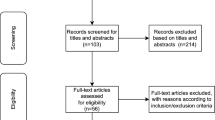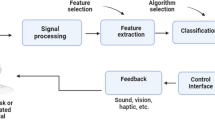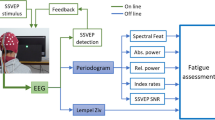Abstract
A brain-computer interface (BCI) system and virtual reality (VR) are integrated as a more interactive hybrid system (BCI-VR) that allows the user to manipulate the car. A virtual scene in the VR system that is the same as the physical environment is built, and the object’s movement can be observed in the VR scene. The four-class three-dimensional (3D) paradigm is designed and moves synchronously in virtual reality. The dynamic paradigm may affect their attention according to the experimenters’ feedback. Fifteen subjects in our experiment steered the car according to a specified motion trajectory. According to our online experimental result, different motion trajectories of the paradigm have various effects on the system’s performance, and training can mitigate this adverse effect. Moreover, the hybrid system using frequencies between 5 and 10 Hz indicates better performance than those using lower or higher stimulation frequencies. The experiment results show a maximum average accuracy of 0.956 and a maximum information transfer rate (ITR) of 41.033 bits/min. It suggests that a hybrid system provides a high-performance way of brain-computer interaction. This research could encourage more interesting applications involving BCI and VR technologies.
Graphical Abstract















Similar content being viewed by others
References
Guger C, Schlogl A, Neuper C, Walterspacher D, Strein T, Pfurtscheller G (2001) Rapid prototyping of an EEG-based brain-computer interface (BCI). IEEE Trans Neural Syst Rehabil Eng 9(1):49–58. https://doi.org/10.1109/7333.918276
Wolpaw JR et al (2000) Brain-computer interface technology: a review of the first international meeting. IEEE Trans Rehabil Eng 8(2):164–173. https://doi.org/10.1109/tre.2000.847807
Wolpaw JR, Birbaumer N, McFarland DJ, Pfurtscheller G, Vaughan TM (2002) Brain-computer interfaces for communication and control. Clin Neurophysiol 113(6):767–791. https://doi.org/10.1016/s1388-2457(02)00057-3
Chen X, Wang Y, Nakanishi M, Gao X, Jung TP, Gao S (2015) High-speed spelling with a noninvasive brain-computer interface. Proc Natl Acad Sci U S A 112(44):E6058–E6067. https://doi.org/10.1073/pnas.1508080112
Wang K et al (2017) A brain-computer interface driven by imagining different force loads on a single hand: an online feasibility study. J Neuroeng Rehabil 14(1):93. https://doi.org/10.1186/s12984-017-0307-1
Wu Y, Li M, Wang J (2016) Toward a hybrid brain-computer interface based on repetitive visual stimuli with missing events. J Neuroeng Rehabil 13(1):66. https://doi.org/10.1186/s12984-016-0179-9
Xu L, Xu M, Jung TP, Ming D (2021) Review of brain encoding and decoding mechanisms for EEG-based brain-computer interface. Cogn Neurodyn 15(4):569–584. https://doi.org/10.1007/s11571-021-09676-z
Mussa-Ivaldi S (2000) Real brains for real robots. Nature 408(6810):305–306. https://doi.org/10.1038/35042670
Horki P, Solis-Escalante T, Neuper C, Muller-Putz G (2011) Combined motor imagery and SSVEP based BCI control of a 2 DoF artificial upper limb. Med Biol Eng Comput 49(5):567–577. https://doi.org/10.1007/s11517-011-0750-2
Dong E, Zhang H, Zhu L, Du S, Tong J (2022) A multi-modal brain-computer interface based on threshold discrimination and its application in wheelchair control. Cogn Neurodyn 16(5):1123–1133. https://doi.org/10.1007/s11571-021-09779-7
Ron-Angevin R, Velasco-Alvarez F, Fernandez-Rodriguez A, Diaz-Estrella A, Blanca-Mena MJ, Vizcaino-Martin FJ (2017) Brain-computer interface application: auditory serial interface to control a two-class motor-imagery-based wheelchair. J Neuroeng Rehabil 14(1):49. https://doi.org/10.1186/s12984-017-0261-y
Lo CC, Tsai SH, Lin BS (2017) Novel non-contact control system of electric bed for medical healthcare. Med Biol Eng Comput 55(3):517–526. https://doi.org/10.1007/s11517-016-1533-6
Vlahovic S, Suznjevic M, Skorin-Kapov L (2022) “A survey of challenges and methods for quality of experience assessment of interactive VR applications, ” (in English). J Multimodal User Interfaces 16(3):257–291. https://doi.org/10.1007/s12193-022-00388-0
Liarokapis F, von Mammen S, Vourvopoulos A (2021) “Advanced multimodal interaction techniques and user interfaces for serious games and virtual environments, ” (in English). J Multimodal User Interfaces 15(3):255–256. https://doi.org/10.1007/s12193-021-00380-0
Cattan GH, Andreev A, Mendoza C, Congedo M (2021) A comparison of mobile VR display running on an ordinary smartphone with standard pc display for P300-BCI stimulus presentation. IEEE Transactions on Games 13(1):68–77. https://doi.org/10.1109/tg.2019.2957963
Shin JH, Ryu H, Jang SH (2014) A task-specific interactive game-based virtual reality rehabilitation system for patients with stroke: a usability test and two clinical experiments. J Neuroeng Rehabil 11:32. https://doi.org/10.1186/1743-0003-11-32
Bonkon K, Hwan-Gon L, Yunjun N, Seungjin C (2015) Immersive BCI with SSVEP in VR head-mounted display. Annu Int Conf IEEE Eng Med Biol Soc 2015:1103–1106. https://doi.org/10.1109/EMBC.2015.7318558
Stawicki P et al (2018) SSVEP-based BCI in virtual reality - control of a vacuum cleaner robot, (in English), 2018 Ieee Int Conf Syst, Man, Cybern (Smc) 534–537 https://doi.org/10.1109/Smc.2018.00749.
Abbasi-Asl R, Keshavarzi M, Chan DY (2019) Brain-computer interface in virtual reality, ” (in English). 2019 9th Int Ieee/Embs Confer Neural Eng (Ner) 1220–1224 https://doi.org/10.1109/NER.2019.8717158
Ke Y, Liu P, An X, Song X, Ming D (2020) An online SSVEP-BCI system in an optical see-through augmented reality environment. J Neural Eng 17(1):016066. https://doi.org/10.1088/1741-2552/ab4dc6
Na R et al. (2021) An embedded lightweight SSVEP-BCI electric wheelchair with hybrid stimulator, (in English). Digit Sig Process 116:103101. ARTN 10310110.1016/j.dsp.2021.103101.
Cattan G, Andreev A, Visinoni E (2020) Recommendations for integrating a P300-based brain–computer interface in virtual reality environments for gaming: an update. Computers 9(4):92. https://doi.org/10.3390/computers9040092
P. Gergondet, D. Petit, A. Kheddar (2012) Steering a robot with a brain-computer interface: impact of video feedback on BCI performance. RO-MAN, 2012 Int Symp Robot Human Interact Commun 271–276 https://doi.org/10.1109/ROMAN.2012.6343765.
Bell CJ, Shenoy P, Chalodhorn R, Rao RP (2008) Control of a humanoid robot by a noninvasive brain-computer interface in humans. J Neural Eng 5(2):214–220. https://doi.org/10.1088/1741-2560/5/2/012
Stawicki P, Gembler F, Volosyak I (2016) Driving a semiautonomous mobile robotic car controlled by an SSVEP-based BCI. Comput Intell Neurosci 2016:4909685. https://doi.org/10.1155/2016/4909685
Gergondet P, Druon S, Kheddar A, Hintermüller C, Guger C, Slater M (2011) Using brain-computer interface to steer a humanoid robot. 2011 IEEE Int Conf Robot Biomimetics 192–197 https://doi.org/10.1109/ROBIO.2011.6181284
Nakanishi M, Wang Y, Wang YT, Mitsukura Y, Jung TP (2014) A high-speed brain speller using steady-state visual evoked potentials. Int J Neural Syst 24(6):1450019. https://doi.org/10.1142/S0129065714500191
Fouad IA, Hadidi T (2015) Classifying brain-computer interface features based on statistics and density of power spectrum. Int J Biomed Eng Technol 18(1):1–13. https://doi.org/10.1504/ijbet.2015.069849
Kalunga E, Djouani K, Hamam Y, Chevallier S, Monacelli E (2013) “SSVEP enhancement based on canonical correlation analysis to improve BCI performances, ” (in English). Africon 2013:620–624. https://doi.org/10.1109/AFRCON.2013.6757776
Lee J-Y, Lee Y-R, Kim H-N (2015) Frequency recognition in SSVEP-based BCI systems with a combination of CCA and PSDA. J Inst Electron Inf Eng 52(10):139–147. https://doi.org/10.5573/ieie.2015.52.10.139
Zhang Y, Zhou G, Jin J, Wang X, Cichocki A (2014) Frequency recognition in SSVEP-based BCI using multiset canonical correlation analysis. Int J Neural Syst 24(4):1450013. https://doi.org/10.1142/S0129065714500130
Chen YJ, Chen SC, Zaeni IAE, Wu CM (2016) Fuzzy tracking and control algorithm for an SSVEP-based BCI system, (in English). Appl Sci-Basel 6(10):270 ARTN 27010.3390/app6100270
Jain PK, Gupta S, Bhavsar A, Nigam A, Sharma N (2020) Localization of common carotid artery transverse section in B-mode ultrasound images using faster RCNN: a deep learning approach. Med Biol Eng Comput 58(3):471–482. https://doi.org/10.1007/s11517-019-02099-3
Li J et al (2017) A unified canonical correlation analysis-based framework for removing gradient artifact in concurrent EEG/fMRI recording and motion artifact in walking recording from EEG signal. Med Biol Eng Comput 55(9):1669–1681. https://doi.org/10.1007/s11517-017-1620-3
Zhang Y, Zhou G, Jin J, Wang X, Cichocki A (2015) SSVEP recognition using common feature analysis in brain-computer interface. J Neurosci Methods 244:8–15. https://doi.org/10.1016/j.jneumeth.2014.03.012
Nwachukwu SE et al. (2019) An SSVEP recognition method by combining individual template with CCA, (in English). 3rd Int Conf Innov Artif Intell (Iciai 2019) 6–10 https://doi.org/10.1145/3319921.3319925
Tello RMG, Muller SMT, Bastos T, Ferreira A (2014) A comparison of techniques and technologies for SSVEP classification, (in English). 5th Issnip-Ieee Biosignals Biorobotics Conf (2014): Biosignals Robotics Better Safer Living 7–12 https://doi.org/10.1109/BRC.2014.6880956
Tong C, Wang H, Wang Y (2022) Relation of canonical correlation analysis and multivariate synchronization index in SSVEP detection. Biomed Signal Process Control 73:103345. https://doi.org/10.1016/j.bspc.2021.103345
Lalor EC et al (2005) “Steady-state VEP-based brain-computer interface control in an immersive 3D gaming environment, ” (in English). Eurasip J Appl Signal Process 2005(19):3156–3164. https://doi.org/10.1155/Asp.2005.3156
Funding
This work was supported in part by the National Key R&D Program of China, grant no. 2021YFC0122700; the National Natural Science Foundation of China, grant no. 61904038 and no. U1913216; the Shanghai Sailing Program, grant no. 19YF1403600; the Shanghai Municipal Science and Technology Commission, grant no. 19441907600, no. 19441908200, and no. 19511132000; and the Yiwu Research Institute of Fudan University, grant no. 20–1-16. Opening Project of Zhejiang Lab, grant no. 2021MC0AB01; Fudan University-CIOMP Joint Fund, grant no. FC2019-002; Ji Hua Laboratory, grant no. X190021TB190 and no. X190021TB193; Shanghai Municipal Science and Technology Major Project, grant no. 2021SHZDZX0103 and no. 2018SHZDZX01.
Author information
Authors and Affiliations
Corresponding author
Ethics declarations
Conflict of interest
The authors declare no competing financial interest.
Additional information
Publisher's note
Springer Nature remains neutral with regard to jurisdictional claims in published maps and institutional affiliations.
Rights and permissions
Springer Nature or its licensor (e.g. a society or other partner) holds exclusive rights to this article under a publishing agreement with the author(s) or other rightsholder(s); author self-archiving of the accepted manuscript version of this article is solely governed by the terms of such publishing agreement and applicable law.
About this article
Cite this article
Niu, L., Bin, J., Wang, J.K.S. et al. Effect of 3D paradigm synchronous motion for SSVEP-based hybrid BCI-VR system. Med Biol Eng Comput 61, 2481–2495 (2023). https://doi.org/10.1007/s11517-023-02845-8
Received:
Accepted:
Published:
Issue Date:
DOI: https://doi.org/10.1007/s11517-023-02845-8




